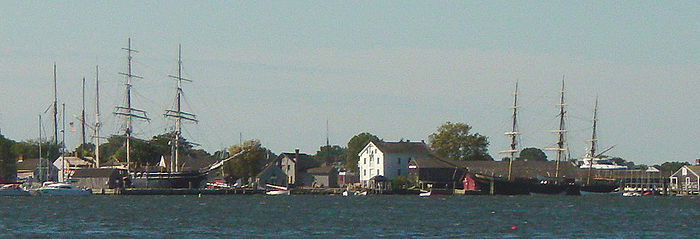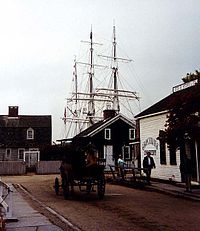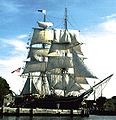- Mystic Seaport
-
Mystic Seaport, the Museum of America and the Sea, in Mystic, Connecticut, is notable both for its collection of sailing ships and boats, and for the re-creation of crafts and fabric of an entire 19th century seafaring village. It consists of more than 60 original historic buildings, most of them rare commercial structures moved to the 37 acres (0.15 km2) site and meticulously restored.
Contents
Overview
The museum was established in 1929 as the "Marine Historical Association". Its first fame came with the acquisition in 1941 of the Charles W. Morgan, the only surviving wooden sailing whaler. The seaport was one of the first living history museums in the United States, with a collection of buildings and craftsmen to show how work was done. The seaport now receives about 400,000 visitors each year.
In addition, it supports research via an extensive library; runs the Frank C. Munson Institute of American Maritime Studies, a summer graduate-level academic program, established in 1955 by maritime historian Professor Robert G. Albion of Harvard University; and, in conjunction with Williams College, hosts Williams-Mystic, an undergraduate program in maritime studies. Outreach includes sailing classes for area children.
Mystic Seaport is a popular destination for boaters, who pay to dock overnight just a short walk away from ships such as the Morgan and the fishing schooner L. A. Dunton.
Vessel collection
Several of the vessels are the unique survivors of their type in the world. The collection includes:
- Annie (sandbagger sloop)
- Australia (coasting schooner)
- Breck Marshall (catboat)
- Brilliant (auxiliary schooner)[1]
- Charles W. Morgan (whaler)
- Emma C. Berry (Noank smack)
- Estella A. (Friendship Sloop)
- Florence (dragger)
- Gerda III (Lighthouse tender)
- Joseph Conrad (training ship)
- L. A. Dunton (fishing schooner)
- Nellie (oyster or shoal-draft sloop)
- Regina M. (carry-away sloop)
- Roann (dragger)
- Sabino (island steamer)
- Star (Fishing vessel)
Four ships have been designated National Historic Landmarks: Charles W. Morgan, L. A. Dunton, Emma C. Berry, and Sabino
Buildings
The Preservation Shipyard is an important part of the museum. It is where traditional tools and techniques are used to preserve the Museum's collection of historic vessels, including a recreation of the ship Amistad. To commemorate the 200th anniversary of the end of slavery in Great Britain, the Amistad embarked on June 21, 2007 from New Haven, Connecticut on a 14,000-mile (23,000 km) transatlantic voyage to Great Britain, Lisbon, West Africa and the Caribbean, marking the Atlantic trade and slave route.
The 19th century seafaring village contains nearly all the types of general and specialized trades associated with building and operating a sailing fleet. They include a chandlery, sail loft, ropewalk, cooperage, shipping agent office, printing office, bank and others. Also included is The Spouter Tavern, open seasonally and serving "travelers' fare". Each building is used both to show the original activity and to display multiple examples of objects sold or constructed; for instance, the nautical instruments shop displays sextants, nautical timepieces and the like. Demonstrations at the cooperage show how barrels are assembled.
Additional buildings house more exhibits. One is a 1/128th scale model of the entire Mystic River area ca. 1870, complete down to the outhouse behind every residence; a model over 50 feet (15 m) long. Another contains a collection of carved ship figureheads. Also among the museum's buildings is a planetarium that demonstrates how seamen used stars for navigation.
Sailing
Sailing instruction is given here, as well as tourist rides at nominal cost in various historical small craft. Such tours give a good overview of historic ships at their moorings.
Music
Mystic Seaport's music program is unusual as it prominently features sea shanties in their original contexts as work songs. Regular sessions find shanty singers keeping museum visitors in line as they haul sails or turn a capstan.
The Mystic Seaport Sea Music Festival, held annually in June since 1979, is among the oldest and largest in the United States.
In popular culture
- Mystic Seaport plays a big role in the Hardy Boys Book #47 Mystery of the Whale Tattoo. The characters like the area, though a villain nearly kills Frank aboard the Charles W. Morgan. It also is where the missing statue is found.
- In 1973, many scenes of the made-for-tv movie The Man Without a Country starring Cliff Robertson were filmed at Mystic Seaport and aboard the Charles W. Morgan.
- In 1987, two scenes for the film Mystic Pizza featuring Annabeth Gish were filmed in the Treworgy Planetarium at Mystic Seaport.
- In 1997, various scenes for Steven Spielberg's movie Amistad were filmed at Mystic Seaport. The village area represented 1830s New Haven, Connecticut.
- In 2005, a commercial for FedEx was shot at Mystic Seaport. It was based on the lobstering business in New England. The commercial was aired in the Orange Bowl. Click here for the commercial.
Pictures of Mystic Seaport
-
Sandbagger sloop Annie
See also
- List of maritime museums in the United States
- List of museum ships
- Famous Sea Captain, Joseph Warren Holmes, many passings of Cape Horn Joseph Warren Holmes
- Whaleboat - examples shown are at Mystic Seaport
- The official Mystic Seaport Podcast ia available on MuseumPods [2] the Museum Podcast Directory.
- John Faunce Leavitt - former curator of Mystic Seaport.
References
- Maynard Bray, Benjamin Fuller, and Peter Vermilya, Mystic Seaport Watercraft. (2002) ISBN 0-913372-94-3
External links
Categories:- Mystic, Connecticut
- Stonington, Connecticut
- Groton, Connecticut
- Museums in New London County, Connecticut
- Maritime museums in Connecticut
- Living museums in Connecticut
Wikimedia Foundation. 2010.












